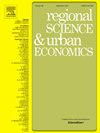零售业的城市经济学
IF 2.9
2区 经济学
Q1 ECONOMICS
引用次数: 0
摘要
利用荷兰 327 个大型购物区的物业数据,我们发现购物区的空间结构类似于一个单中心城市的缩影。就像单中心城市一样,一个购物区有一个明显的中心,在这个中心,租金最高,空置率最低,而从这个中心到边缘,零售租金呈负梯度。每 100 米的平均零售租金梯度为-17%,边缘的空置率是中心的 1.5 倍。从短期和长期来看,我们的模型都能揭示购物区如何应对需求下降。我们的数据涵盖了 2009 年至 2012 年的经济大衰退,为这些预测提供了支持。本文章由计算机程序翻译,如有差异,请以英文原文为准。
The urban economics of retail
Using property-level data from 327 larger shopping areas in the Netherlands, we show that the spatial structure of a shopping area resembles a monocentric city in miniature. Just like a monocentric city, a shopping area has a pronounced centre where the rents are the highest and the vacancy the lowest, and a negative retail rent gradient from this centre to the edges. The average retail rent gradient is −17% per 100 m distance, and the vacancy is one and a half times higher at the edge than in the centre. Our model gives insights into how shopping areas respond to downfall in demand, both in the short and long run. Our data, covering the Great Recession, from 2009 to 2012, lend support to these predictions.
求助全文
通过发布文献求助,成功后即可免费获取论文全文。
去求助
来源期刊

Regional Science and Urban Economics
Multiple-
CiteScore
5.30
自引率
9.70%
发文量
63
期刊介绍:
Regional Science and Urban Economics facilitates and encourages high-quality scholarship on important issues in regional and urban economics. It publishes significant contributions that are theoretical or empirical, positive or normative. It solicits original papers with a spatial dimension that can be of interest to economists. Empirical papers studying causal mechanisms are expected to propose a convincing identification strategy.
 求助内容:
求助内容: 应助结果提醒方式:
应助结果提醒方式:


